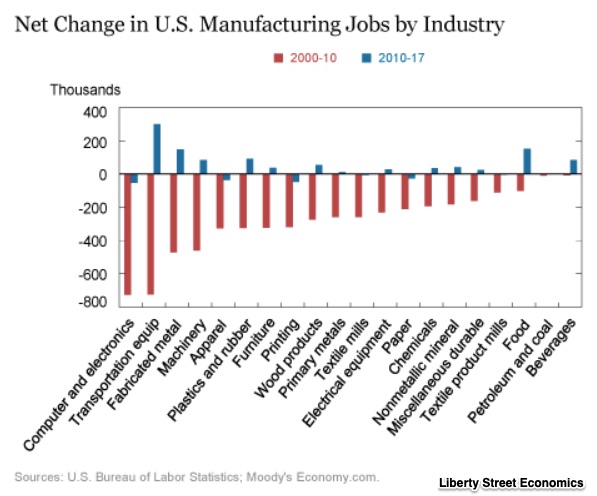Years ago I was asked, “Why don’t we make things anymore?” My answer was, “We do.”
Now I have an update.
Manufacturing Jobs
1. Since 2010, the U.S. has added 1 million manufacturing jobs
However the rebound is modest. Job losses between 2000 and 2010 were close to 5.7 million.
2. Technology and globalization were the primary reasons for the decline in manufacturing jobs.
Fueling productivity, technology eliminated jobs. At the same time, U.S. manufacturing was challenged by global competition and outsourcing. So, although you can see that declines occurred during recessions, the contraction was not the main reason.
3. Certain industries lost more jobs than others.
Computer and electronics manufacturers and transportation equipment makers lost the most jobs from 2000-2010. Now though, transportation is one of the leaders of the recovery. 
4. We can find the transportation rebound in “auto alley.”
As overseas labor and shipping became more costly, automotive jobs increased in the U.S. Grouped in one strip that is 100 miles wide and 700 miles long, the area with the rebound has been called auto alley.
5. The U.S. remains one of the leading manufacturing nations in the world.
In 1970, the U.S., the USSR, and Japan were the top three for manufacturing output. Now Russia is #15 and the U.S. moved down to #2.
6. The U.S. is among the top three for its friendly manufacturing environment.
Brookings used 20 indicators to rank a country’s manufacturing environment. Their indicator categories included tax policy, open trade, energy, workforce quality, innovation, and infrastructure. While the U.S. was close to the top, Russia (#56) and India (57) were at the bottom.
Our Bottom Line: Unemployment
We could name four basic causes of unemployment.
- Cyclical: Referring to the business cycle, cyclical unemployment diminishes after a recession.
- Frictional: Involving quitting, firing, and other everyday reasons for leaving a job, frictional unemployment is always with us.
- Structural: When jobs are lost because of fundamental changes in the economy, we say the cause is structural.
- Seasonal: As the calendar unfolds, businesses need more employees during certain times of the year than others.
Many of the recent manufacturing job losses and gains have been structural.
My sources and more: Liberty Street Economics (NY Fed) had the manufacturing story in two posts. Brookings had the world scorecard. For more facts, I recommend both.











I really like the analysis of the data that you included. Very important to see these examples given the rhetoric around “failing industries” in the US.
Do you see a chance for an update to this article?
Thanks for the “nudge.” I will do an update during the next week.